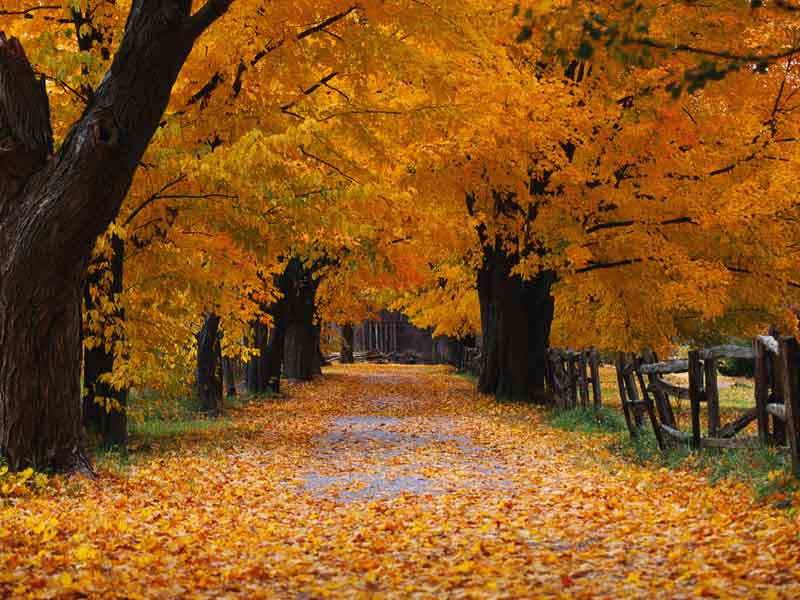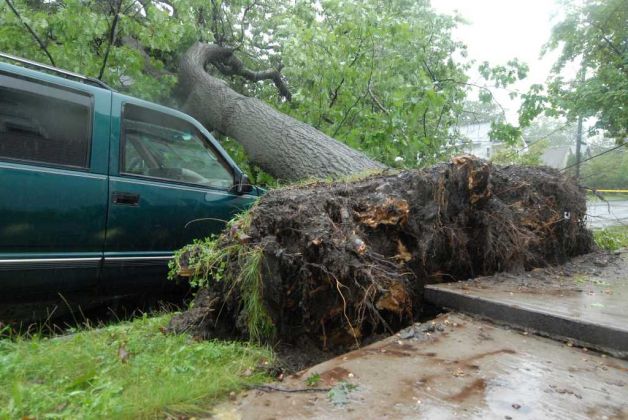|
Trees in the wild need nothing from us. They thrive or fail on their own. As with animals, stronger trees will dominate weaker trees in the battle for nutrients and sunlight. Nature sorts that out without human input. But take one of the largest living things on earth and let it tower and sway next to your house and instantly human input seems prudent. Removing a tree is less expensive than replacing a house but there are several things that can be done to preserve the tree (and the house) while saving a great deal of money. Planning is key. Calling an arborist one day before a major storm should not be a homeowner's tree care plan.
Here's a few things we can do to save you money and minimize risk to people and property: 1. Soil injections to eliminate destructive pests and overcome any shortcomings in a tree's diet. These are relatively inexpensive, quick, and can be done early in the year in most cases. Make certain that your applicator is licensed. The chemicals used are controlled items and not available to vendors without special training and licensing. Unfortunately, this is often an area where fraud is committed through the substitution of products. You can always ask to see a licensing certificate. 2. Weight reduction. Trees can overgrow, gaining more weight on limbs than they can support. The loss of a major limb may be the death of a tree. Of course, in the forest this happens all the time but we don't want our nice lawn trees to start dropping wood in the backyard. A trained climber under the general guidance of a certified arborist can reduce weight on an overgrown tree without inhibiting the tree's ability to drink, eat, and breathe. Weight reduction needs vary but tend to be good for 2-5 years. There are exceptions, of course. During droughts and extreme heat, trees will take on a lot of water quickly. Water is heavy and constantly running inside of a healthy tree. Trees fail in the Sacramento area during severe heat because of weight/water intake. A little preventive maintenance can save the homeowner a lot of money and present a much nicer looking tree. 3. Limb cutbacks are needed when wood has grown in such a manner as to be beyond what the crotch of that limb can hold, endangers another limb, or threatens utility lines or buildings. A broken limb will invite disease. A properly cut limb can prevent premature failure and the expense of removal. 4. Arborist consultation. Have an arborist inspect your tree. Most trees don't need fertilization but some must have it. A certified arborist can advise you in selecting necessary preventive care. Many times, owners need less work than they think. Ask for an annual tree care plan for your individual trees. A little money spent throughout the year can save you up to several thousand dollars of emergency work. Hundreds can save thousands with trees but the work has to be done before the crisis occurs. Trees are like nothing else we own. Once they are gone, that's it. We can replace the car and the gazebo but your favorite tree is like no other. A beautiful oak tree, towering in your backyard cannot be replaced in three or four lifetimes. In most cases, a little care will keep a tree sound and healthy for generations. It just takes a little planning. Happy New Year.
6 Comments
The founder of Bud's Tri-County Tree Service and the man who served as a father to me for much of my youth, Bud Phipps, passed away yesterday at 76 years old. Bud was recently diagnosed with lung cancer. Many of our friends will remember Bud. We still have customers that Bud first served back in the early seventies. Though retired to Oregon, Bud came down every few months to help with a couple of his old accounts. He remained active throughout his life, even up to to his recent hospitalization.
Bud Phipps will be sorely missed. We wish all our friends, a very Merry Christmas and a joyful 2015. In the days preceding last week's storm we received an incredible amount of calls requesting preventive trimming, limb cutbacks, and tree removal. Property owners were rightly concerned that overgrown trees, sick trees, and dead trees were likely to fail or drop heavy debris during the storm. The problem for tree companies is time and resources. After the storm hits, work is largely based on emergency needs. Before the storm hits, there is already scheduled work for new customers as well as preventive work for maintenance customers. Storm work involves crews working extended hours under extreme conditions which drives labor costs upward. Waiting for a storm, before scheduling tree work is very likely to dramatically increase customer cost. Storm work may continue long after the rain and wind have passed. Trees may fall as a result of soil failure rather than the immediate result of wind. Drought-thirsty soil can't handle excess water and losses the ability to securely hold trees. In other words, this entire season is, in a sense, a giant storm
The answer to storm preparation is to call a licensed tree company with an on-staff certified arborist, now. Problems must be addressed in advance of the next storm to allow time for the work to be done and to prevent additional cost. A free estimate from Bud's Tri-County Tree Services is, well, free. If you think that one of your trees is likely to be a hazard during the next storm, now is the time to get a professional opinion. Trees react. When crowded, younger trees will often grow at an angle to escape the shade of larger neighbors. Similarly, trees also react to long drought cycles by growing roots nearer the surface in order to capture available moisture. When heavy rains finally arrive, tree without good deep roots are susceptible to falling. These occurrences result in the entire tree simply uprooting and falling intact. Generally speaking, very old established trees have endured enough drought and flood cycles to have developed a reliable root system. While its not always the case, age is a pretty good indicator of a tree's ability to survive. Failures due to soft, rain-drenched ground often occur without much warning. Take a moment and study the trunks of trees around your home. Get a weekly perspective of the trunk against a fixed object like the corner of your house. If you notice a trunk tilting even slightly, call an arborist.
There's not much we can do about ending the drought but we can reduce some of the risks by watering properly throughout the year, using fertilizer injections when appropriate, trimming for weight reduction and access to sunlight, and minimizing water, soil, and nutrient competition for our trees. Let's pay attention to our trees during these current rains. If you have question, please give me a call: 1(800) CUT-TREE. |
Stacy W. BarkerStacy is the owner of Bud's Archives
March 2016
Categories |



 RSS Feed
RSS Feed